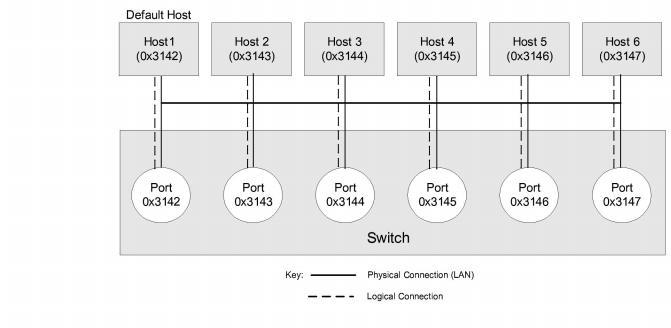
You are here: CSP Developer’s Guide: Overview > 3 Getting Started > Multi-Host Control

With Multi-host Control, the Excel platform can communicate on the LAN with up to six hosts simultaneously and you can run a different application on each host. For example, you can run a call control application on one host, a configuration and administration application on a second host, and an alarm management and status application on a third host.
Important! If the connection to a host is dropped, a General Alarm of Major severity is sent to indicate that a connection to one of the hosts has been dropped.
Multi-host Control provides the following benefits:
• Host redundancy
• Greater control of Excel platform management
• Greater bandwidth for the host port
• Faster response to time-critical messages such as Request For Service
The hosts connected to the Excel platform have host IDs between 0x3142 and 0x3147. The host connected on port 0x3142 is the default host.
Figure 3-5 Multi-Host Configuration

Multi-Host with
Multiple Nodes
Only host nodes can be configured with Multi-host Control. If you send a Multi-host Configure message to a node that is not a host node, a negative acknowledgment (NACK) is returned, with a status of No Host Attached (0x500E). If a host node with Multi-host Control enabled is reconfigured as a slave node, Multi-host Control is automatically disabled on that node. If the node is subsequently reconfigured as a host node, the host application must re-enable Multi-host Control on that node.
To enable Multi-host Control, you must modify applications that use multiple connections to communicate with the Excel platform. You do not need to modify applications that communicate through a single connection. You can add new applications without changing existing applications. Opening new control ports and adding new applications does not affect an existing application that uses the original control port.
Multi-host Control creates extra demand for processing resources, so it may cause a slight delay in the host-to-Excel platform response time.
Requirements for
TCP Connections
Each of the six host ports (0x3142 to 0x3147) is defined as an Ethernet TCP socket connection.
Port 0x3142 is the default host port. It is also the primary connection to the Excel platform. The host connected to this port is the default host for all Excel platform-initiated messages that cannot be routed to any of the hosts. Messages cannot be routed if no host registered for that particular message.
Ports 0x3143 to 0x3147 receive Poll messages from the Excel platform at an interval configured by the default host. These ports cannot unregister for Polls.
Important! The memory buffer for host ports 0x3143 to 0x3147) is 4K. Host port 0x3142 has a larger send buffer of 32K. Applications with the most messaging should be connected to host port 0x3142 because it has much greater bandwidth. If an application with intensive messaging is connected to one of the four ports with the 4K bandwidth, a socket could be closed down.
Configure Software for Multi-Host
Multi-host Control is disabled by default, but if it is enabled, Multi-host Control remains enabled after any reset. Excel platform-initiated message configuration is maintained throughout reset. The default host is the only host that can enable or disable Multi-host Control, and it does so by sending the Multi-host Configure message to the Excel platform.
When Multi-host Control is externally disabled, the Excel platform cannot communicate with the hosts connected to ports 0x3143–0x3147, even though those hosts are still physically connected to the Excel platform.
If you attempt to connect a host to a port that already has a host connection, the new host is connected and the original host is disconnected.